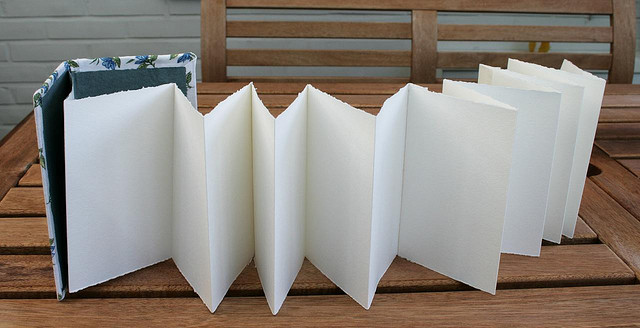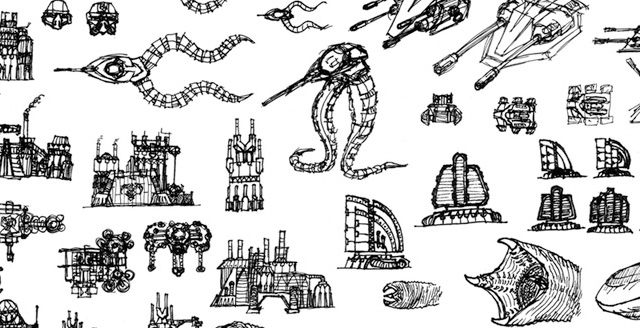Sifting the Sands - Part 1
A beginning is a delicate time.
Whenever I approach a new design, the most difficult part is before pen ever touches paper. (Yes, I still do use paper, in addition to digital tools). No matter what I'm designing, the first part of any design needs to be an idea. Sometimes ideas come quickly, unbidden, the kind of thing that you have to scribble down before it slips out of your mind on a passing breeze. Sometime you have to work at it and keep shaking that piggy bank until some shiny change falls out.
For both of these occasions there is no greater tool than a sketchbook. I always have one on hand. If you've trying to choose a sketchbook, pick one that fits easily into a piece of clothing that you wear often: a jacket, a backpack or, in my case, the leg pocket of my cargo pants. The smaller, the better. Working small not only means you can work anywhere, but you can work out a lot of ideas more quickly if they're too small for you to get lost in the details. Always carry a pen too, or your sketchbook isn't really much use. You could draw in blood, but I wouldn't recommend it.
I use one similar to this:
But you can pick whatever form factor and page configuration works best for you.
When I sit down to sketch I always ask myself questions which I must then answer through design. Questions like: "How does this vehicle move?", "What does this creature eat?", "What kind of life does this character have?" etc. Since design should always illuminate story, answering these questions visually allows the audience to connect with your creations beyond their surface appearance and makes them more believable, since the design gives them additional information that they may not even be consciously aware of. This kind of thinking needs to happen before and during the actual drawing process. Always think about these basic considerations and the forms that answer them before you work on styling. Style can always be adapted to fit whatever genre you want this design to match, but form is the structure that has to be beneath it.
The freedom of filling a book with small "thumbnail" sketches is that you can explore and iterate ideas very quickly in order to pick a direction in which to focus your efforts. This is the result:
Not all of what you produce is going to make the cut. This page contains many alternate designs which were abandoned for various reasons and some ideas that are not yet fully developed. Never throw any of this stuff away, often looking back at pages like these will help spur new ideas and remind you of things you've already tried.
Next time I'll show you how a design goes from this chaotic rough state to a detailed drawing, and then to a final painting.
Nathan
D:WS Art Director, Concept Artist

We hope you’ve enjoyed this sneak peek into the development of Dune: War of the Spice. To track our work, please use the buttons at the bottom of this post. We aim to post regular monthly updates as we have new work to show.
Dune: War of the Spice is a new fully original Real Time Strategy game loosely based on the Dune novels of Frank Herbert and following in the footsteps of such games as Emperor: Battle for Dune and Dune II: Building of a Dynasty. The game follows the exploits and conflict between the three Great Houses of the Atreides, Harkonnen and Ordos in their fierce battle for power and control of the Imperium, as well as a number of Subhouses that try to use the conflict to their own advantage.
We’ve been concentrating on the Harkonnen faction for the time being and hope to add new art for the others as our output increases, we’re always on the look-out for talented 2D and 3D artists to contribute. For information on joining the project please click here.













What would you say is the best method for transposing concepts from a book to machine is? I have a scanner, but I don't like tearing pages out, so I trace the picture in with my tablet, but that doesn't always work out so well either. Of course, the kind of sketch book you're showing off there looks like it makes scanning easy.
It depends on the kind of fidelity you're working in, I've used several methods:
1. I used to do my high-detail linework by hand on a sheet of vellum from a pad, taped down on a drafting board with a combination of non-reproducing blue pencil for sketching and construction lines and finals with a Pilot precision fine-line pen. I would then scan the line drawing (which was easy since it's a single sheet) and do the color in Photoshop.
2. Now I do all my linework digitally directly in Photoshop using a Wacom Cintiq tablet screen. They're expensive, but very worth it. I generally don't scan my sketches to use as a baseline for a finished drawing, instead I place my sketchbook next to my screen for reference but I build the final essentially from scratch. I do this for several reasons, firstly sketches are low-detail and may not have exact perspective so using them as underlays can introduce perspective issues into the final drawing if you're not careful; secondly I take the opportunity in transcribing the drawing to a higher level of refinement to iron out things that I may not have had to deal with in the thumbnail sketch, like detail density and stylistic elements.
These aren't hard rules, that's just my personal method. I think the accordion-style book would make for ease of scanning because it eliminates the troublesome spine that bound sketchbooks have. When I scanned these drawings for the image above it was pretty easy and I could do several panels at a time like a filmstrip. If you're using a book built like this at a larger size and producing more refined lineart I think that might be a good way to go.